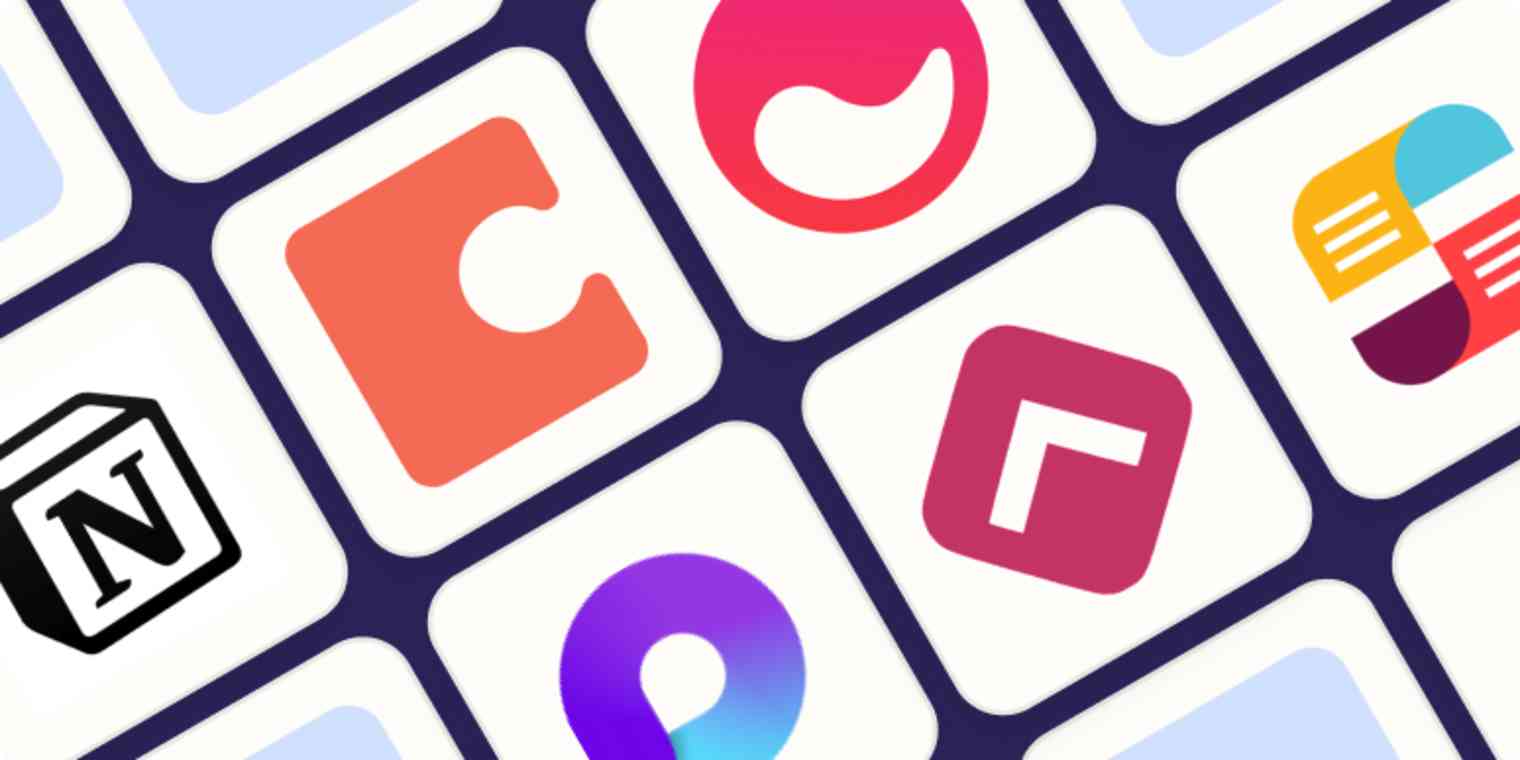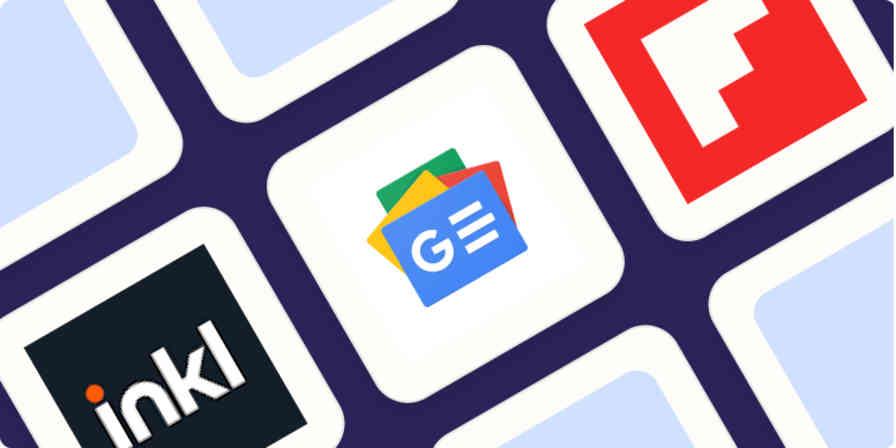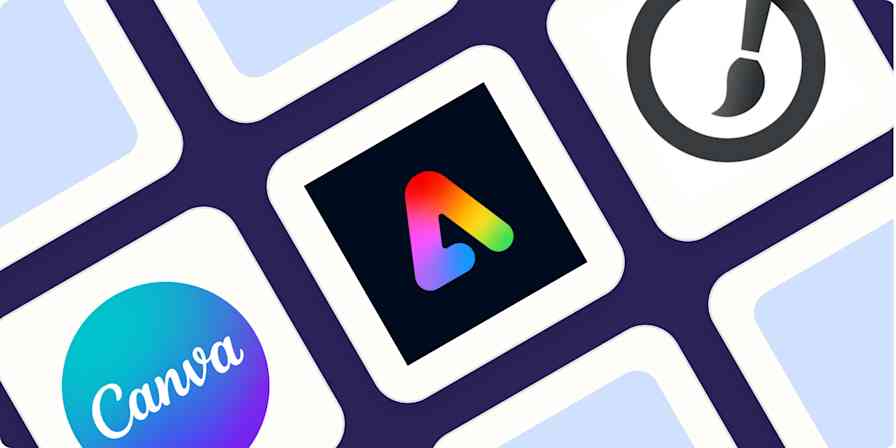Notion is a special app. Starting from an empty screen, you add notes and documents in a freeform way. Then, when the original page is too crowded, you create your first database and the possibilities explode: you can create a custom productivity system and change it as you evolve.
It's amazing to look at something you built yourself and see that it works well. But after the honeymoon period, power users start feeling the edges of freedom, very much like Truman inside his show. You expect the app will accommodate your every wish and command, only to find that there are, in fact, limitations.
If you've been considering a Notion alternative—or strapping a dozen apps together to get all the features you want—you're in the right place. I've been keeping an eye on this category for two years now. I've considered over 100 Notion alternatives with similar features, and while most aren't even close in terms of user experience, there are more and more worthy possibilities. Let's check them out: the best Notion alternatives.
The 8 best Notion alternatives
Coda for powerful formulas and databases
Mem for AI-powered organization
Microsoft Loop for Microsoft 365 users
Slite for managing knowledge with AI features
Almanac for team alignment
Anytype for privacy, security, and data relationships
Scrintal for mind mapping
Obsidian for fearless tinkerers
And, of course, Notion itself.
What makes the best Notion alternative?
How we evaluate and test apps
Our best apps roundups are written by humans who've spent much of their careers using, testing, and writing about software. Unless explicitly stated, we spend dozens of hours researching and testing apps, using each app as it's intended to be used and evaluating it against the criteria we set for the category. We're never paid for placement in our articles from any app or for links to any site—we value the trust readers put in us to offer authentic evaluations of the categories and apps we review. For more details on our process, read the full rundown of how we select apps to feature on the Zapier blog.
Ideally, a great Notion alternative gives you the freedom to create your own productivity system—your network of documents, databases, and references—without forcing an inflexible user experience on you.
A bit like a sandbox video game, this app category (which doesn't really have a name yet, but I've seen Work OS and Digital Workspace rising as possible ones) gives you the possibility to mix and combine different elements to create your or your team's all-in-one workspace.
Each of the picks on this list has something unique to offer, along with some twists on the original experience you're used to. But to start, I evaluated all the apps I tested using the same criteria:
Document and note-taking features. How easy is it to create, format, share, and embed content? This blank-slate document vibe is the bread-and-butter of Notion, so I wanted to be sure the alternatives stacked up.
Project management and collaboration features. Can you create to-do lists? Kanban boards? What about leaving comments on documents? Can you mention coworkers?
Data organization. Notion offers databases to help you organize your pages and create systems, so I was looking for equivalent features the competition is offering: folders, tags, views, or other original methods.
Performance and user experience. I was paying attention to speed, how the search function works (and where it searches), as well as other details, like the quality of the user interface, onboarding experiences, and available support.
All-in-one potential. Based on all the above, could this app reliably hold all your information and processes in one place without requiring you to connect loads of apps together?
In making my final picks, I tried to make sure that each app was relatively well-rounded, even if each one takes a unique approach.
The best Notion alternatives at a glance
Best for | Standout feature | Pricing | |
|---|---|---|---|
The gold standard of an all-in-one workspace | Flexible databases with various views | Free plan with unlimited blocks; paid plans from $8/user/month | |
Powerful formulas and databases | A structured approach to workspaces | Free plan with up to 50 objects; paid plans from $12/document maker/month | |
AI-powered organization | AI that tags and organizes your content | Free plan with 5GB of storage; paid plans from $14.99/month | |
Microsoft 365 users | Loop Components for dynamic content blocks | Part of Microsoft 365 for Business starting at $12.50/user/month | |
Managing knowledge with AI features | AI-powered Ask button for instant answers | From $10/user/month | |
Team alignment | Advanced document versioning and approval processes | From $59/month for up to 10 users | |
Privacy, security, and data relationships | Bidirectional linking for visual constellation charts | Free with 1GB cloud storage; paid plans from $99/year | |
Mind mapping | Card organization and hierarchy features | From $6.99/month | |
Fearless tinkerers | Customizable with plugins and local storage | Free for personal use; paid plans from $4/month |
The gold standard
Notion (Web, Mac, Windows, iOS, Android)
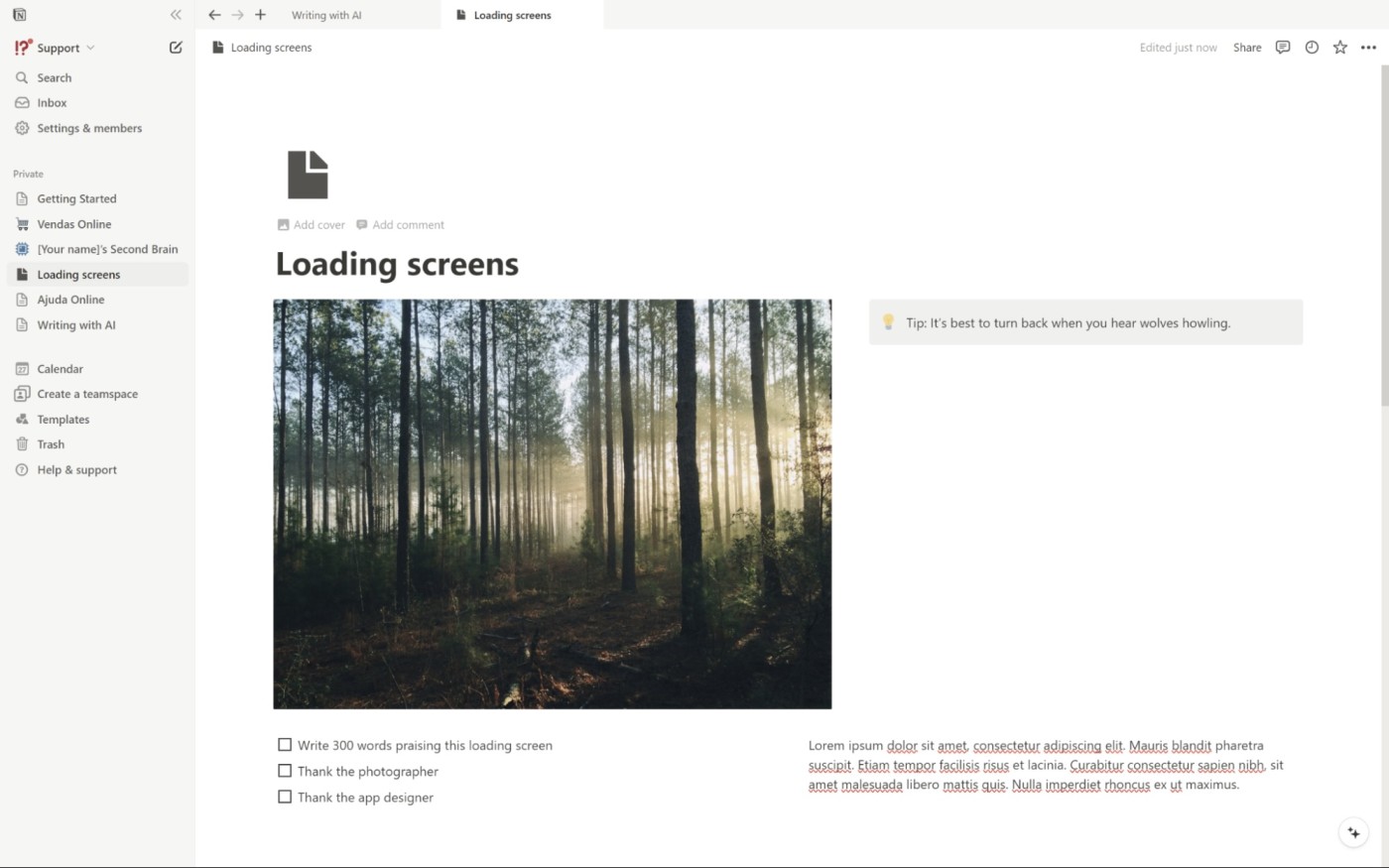
Notion pros:
Extremely flexible
Generous free plan
Notion cons:
No offline mode
Some performance issues
A list of Notion alternatives wouldn't be complete without naming the elephant in the workspace. Unique and powerful, using Notion for the first time feels like you found the One App, the app to replace them all. You can finally focus on building your own information hub and customizing it the way you want to.
Just in case you're not a Notion fan already, here's a brief rundown of everything it offers:
The user experience is minimalistic, putting your content at the forefront of the experience. The tool explains itself as you grasp the basics of building blocks, pages, and databases. You can use these to organize your tasks or documents, create dashboards, or build mini-apps.
Notion databases are super flexible, letting you create pages with attributes and then organize them by creating views. You can use them to create a CRM, a content calendar, or a meeting tracker—the possibilities are nearly endless.
You can bring your team to your workspace and manage work projects, too. Leave comments and mention people on each page or building block, turn pages into wikis, and use the database features to keep track of tasks and subtasks, setting up Gantt or Kanban views to move work forward.
And you can tap into a variety of extras, ranging from configurable buttons to automate tasks to accessing page analytics and history. You can even leverage the power of generative AI on your docs using Notion AI and ask questions to your workspace with Notion Q&A.
With so much on offer—coupled with a generous freemium model—it's no wonder Notion feels like the ultimate all-in-one workspace experience. But this experience isn't without its hiccups. The platform has been widely criticized for performance issues, lack of end-to-end encryption or offline mode, a clunky mobile experience, and the way some searching features have a temperament of their own.
Now, are there solid alternatives to explore? Yes, there's a lot of exciting software. However, there isn't one app that blows Notion out of the water. The alternatives may be better for you because they fit your use case, not because they're much better than the original.
So, if your Notion love story has reached long silences and cold shoulders, keep reading for some options to ignite your all-in-one productivity spark again. And if you're not ready to switch, that's ok. Connect Notion to Zapier, so you can upgrade your Notion experience and connect it to the other apps you use. Learn more about how to automate Notion, or get started with one of these templates.
Add new Google Calendar events to databases in Notion
Generate detailed events in Google Calendar from new Notion database items
Save new tasks in Google Tasks in Notion databases
Notion pricing: Free for unlimited blocks for individuals, up to 5MB per file upload, and 10 guest collaborators. Plus plan starts at $8/user/month.
Best Notion alternative for powerful formulas and databases
Coda (Web, iOS, iPadOS, Android)

Coda pros:
More structured workspace experience
Better integration of AI with databases
Coda cons:
Steeper learning curve than Notion
This user on Reddit said it best: if you handle documents and wikis, Notion is stronger; if you need databases and more automation, Coda comes out on top. There's no clear winner between the two apps. It seems each acts on the shortcomings of the other.
There are two reasons why Coda edges ahead in databases. First, there's a handy form view that you can share with respondents to gather data or run surveys—you'd have to integrate something into Notion to be able to do the same there. Second, Coda's databases are more flexible as they let you work with formulas both inside and outside them, connecting logic and data no matter where you are. Start by typing = anywhere, and away you go.
You can also see this flexibility in how Coda AI works with databases and tables to streamline prompts: you can ask to generate a blog post idea for each row, and then ask to generate a summary for each idea on a new column. These features are useful whether you want a big-picture view of the content in your workspace or to speed up prompting, especially if you're doing it at scale.
Coda handles its integrations well: with Coda Packs, you can embed content from other apps directly into your documents. I connected Coda with Google Calendar, which unlocked a set of elements and formulas I could put in the document to show my schedule and add new events with a button. It's like a toolbox to bring Coda together with other apps, so you don't have to keep a billion tabs open to go around your workday.
Coda is probably Notion's most direct competition and the most natural alternative to it. If you value a powerful database and spreadsheet experience at the core, with the ability to add formulas anywhere, then Coda is the app for the job. And you can take advantage of it even more by connecting Coda to Zapier, so you can automate your business-critical workflows. Learn more about how to automate Coda, or check out these examples to get you started.
Create rows in Coda docs when new messages are posted to Slack channels
Save new Google Form responses to tables in Coda docs
Coda pricing: Free plan offers up to 50 objects (pages, tables, etc.) and up to 1,000 rows per doc for shared documents (private ones are unlimited). Pro starts at $12/document maker/month—viewers and editors are free.
Best Notion alternative for AI-powered organization
Mem (Web, iOS)
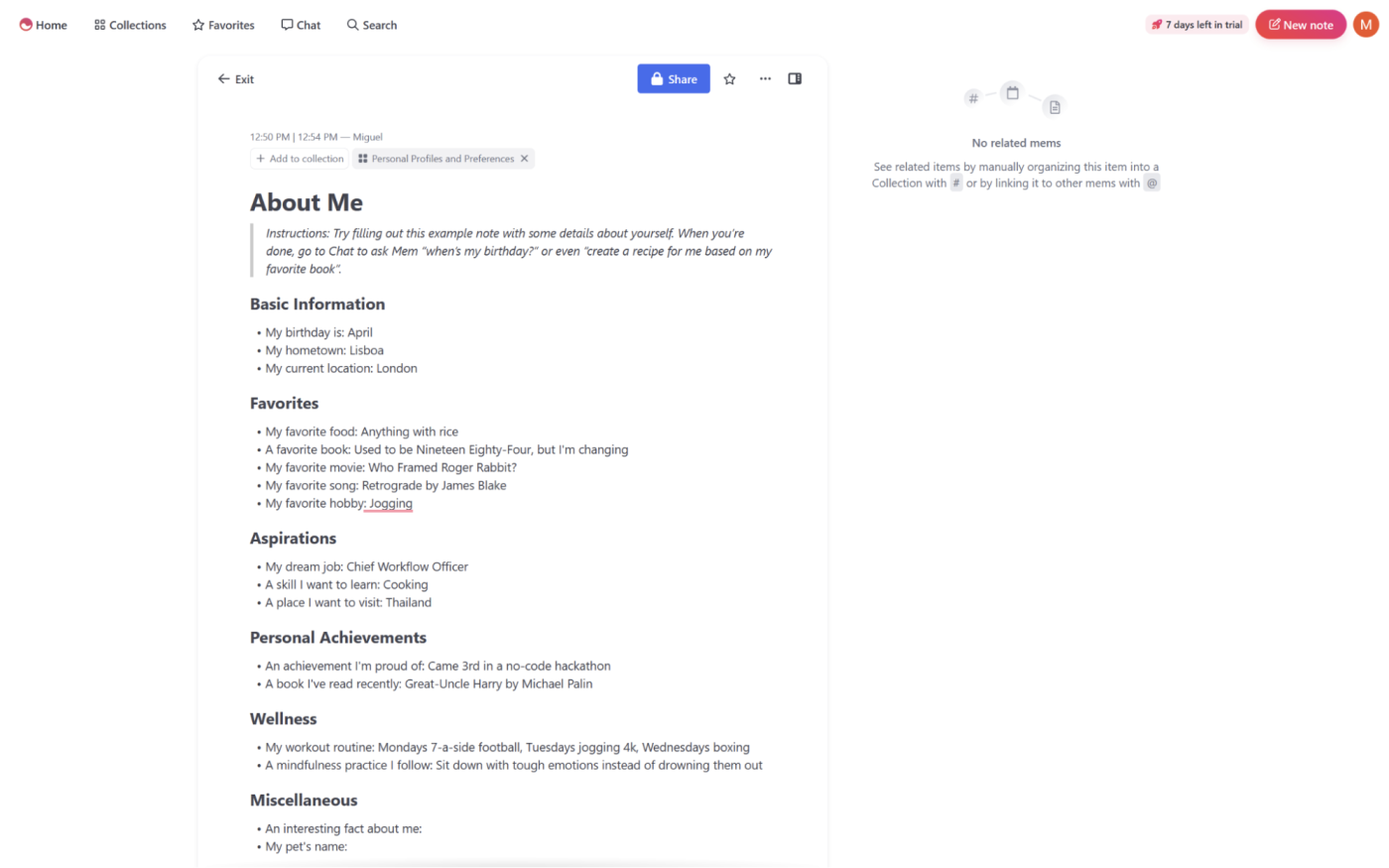
Mem pros:
Helps you find notes and documents faster
Smooth user experience
Mem cons:
Very focused on personal productivity
Keeping your knowledge organized feels like good work. But do you track the time you take organizing your notes? If you're spending more time on organization than you are taking notes, Mem is here to save you.
Most apps use AI to help you fill your docs with generated text or images. Mem goes one step further by using AI to actually tag and organize your content, so you don't have to.
Start by adding your notes in the Home section. This screen is the base for adding content and reminders or marking your favorite mems. Then, set up the Google Calendar integration, and finish by syncing your email inboxes. You'll be able to see your events and conversations inside Mem and add notes to keep track of important information.
As you go about your day, Mem will use AI to understand the core topics and group them into tags. You'll be able to access these tags from the left-side menu, and as you browse each one, you can see suggestions to add more mems. This way, the chances of creating a note you'll never see again are much slimmer.
Mem also has good support for task management. The Tasks section rounds up all there is to do, offering a set of keyboard shortcuts that make a tactile experience out of adding and completing tasks. Mark tasks as done by pressing enter, or defer tasks into the future by pressing the right arrow and typing a better date.
I like how easy it is to send information over to Mem. You can create new mems by sending emails to your account, writing a text message, or using WhatsApp or Telegram. There's also a flow that lets you summarize social threads with AI and save them to your Mem, too.
But the connection possibilities don't end there. When you connect Mem to Zapier, you can bring even more data in and out of Mem. Learn more about how to automate knowledge management with Mem and Zapier, or get started with one of these workflows.
Create mems in Mem from new pushed messages in Slack
Create mems in Mem for new emails matching searches in Gmail
Mem price: Free plan with 25MB per file upload and 5GB of total storage. Mem X starts at $14.99/month, adding self-organizing AI features to your mems.
Best Notion alternative for Microsoft 365 users
Microsoft Loop (Web)

Microsoft Loop pros:
Deep integration with the rest of the Microsoft 365 suite, including Copilot.
Offers dynamic content blocks that you can embed in other 365 apps
Microsoft Loop cons:
No relational database features
Microsoft has been hard at work lately. If you use Office apps and have all your data on the Microsoft cloud, Microsoft Loop is a great option to tie it all together.
Loop isn't as feature-rich as Notion—not yet, at least—but it has all the features you need to start gathering information and collaborating with your team. You can create documents, adding content blocks with slash commands, styling and sharing them with others as needed. There's a section where you can jot down your ideas, and you can always access these from the left-side menu, no matter which workspace you're hanging out in.
When creating a new workspace, you can fill it with documents created inside Loop and also add links to the left-side menu, just in case you need to link to valuable resources quickly. You can leave comments on each block or react with emoji to let your teammates know they're on the right track.
But the best feature available is Loop Components. You can convert any content block into a component. Then, you can share it via Teams, Outlook, or Word, and the content will always be synced no matter where it's showing. It will also be updated no matter where you interact with it, so it's really handy to share live updates or gather feedback. It feels like Loop is meant to be the connector that brings all Microsoft 365 apps together, making it a great addition to the software suite.
There are AI features here, too. Microsoft Copilot—the product that brings AI features to Microsoft apps—is there to generate content, rewrite text, and summarize pages for you. To unlock these features, you'll need a Microsoft Copilot Pro business subscription (they're not available in the base version).
Microsoft Loop price: Part of the Microsoft 365 for Business subscription, starting at $12.50/user/month for the Standard tier. AI features unlocked via Microsoft Copilot Pro Business for $30/user/month.
Best Notion alternative for managing knowledge with AI features
Slite (Web, iOS, Android, Mac, Windows)
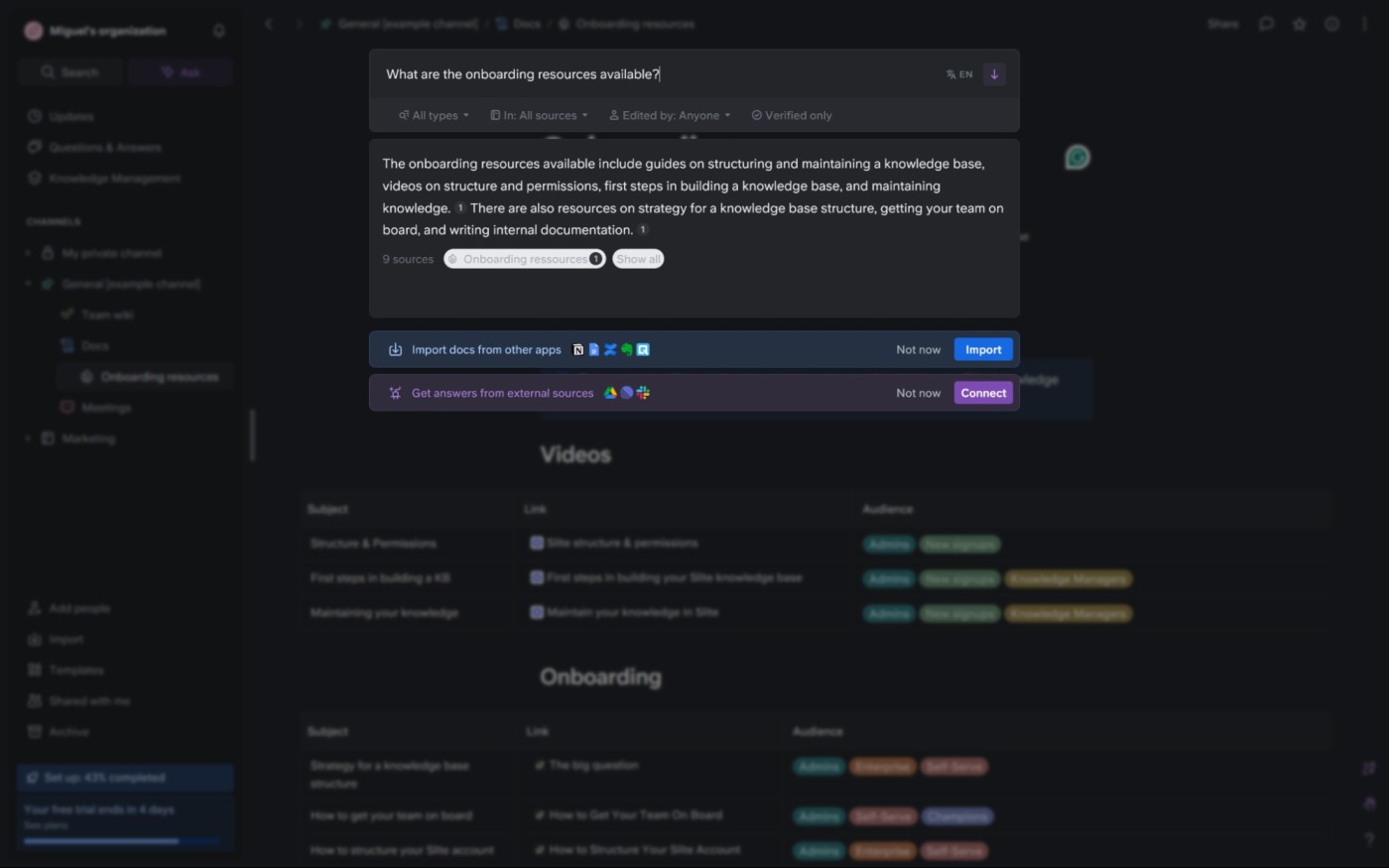
Slite pros:
Strong collaboration features
Top-notch knowledge verification tools
Slite cons:
The user interface looks busier than Notion
AI may still have a way to go as far as creativity goes, but it's already superb for summarizing, analyzing, and formatting data. If your workspace is a mess of information that's hard to search, Slite will help you make sense of everything.
The first place where you'll notice AI is in the Ask button. It generates the answers to your questions on the spot, helping you find the information you're looking for quickly, without having to click to read documents. But if you still need to read them, there are quick links for jumping right into the action.
You can include or exclude document types when generating AI answers, so the output only contains the data you want to see. One especially useful filter is Verified documents only: as you use the knowledge management features to tag which pages are current and which aren't, you can set the AI to only use the most up-to-date information and disregard the rest. The knowledge verification seal expires every six months, so you'll be forced to revisit everything from time to time.
But this isn't the end of it. When you open a document and look at the bottom-right purple buttons, you'll find two additional AI features:
The first one is quite standard but useful: it lets you ask questions about the document. You'll get a big-picture summary of the entire content.
The second one is more surprising: it improves the content with AI in a way that I've never seen before. After clicking the button, an overlay appears with two tabs side-by-side: on the left is the original document; on the right the regenerated one. This helps you compare and see whether the AI generation is better than the original. You can tell AI to take care of the formatting, shorten the doc, translate it into other languages, or run a tone change. You don't have to accept these changes if you don't like them: use the Accept or Deny buttons to make your choice.
These intelligent tools sit on top of a workspace app already strong for collaboration. You can organize your knowledge by team or area of specialization: simply create channels and start adding documents and collections (Slite's name for databases). The platform helps you add, structure, retrieve, and keep your truth up to date.
And if you want to automate that, you can: connect Slite to Zapier, and start saving time while staying accurate. Here are a few examples to get you started.
Update Slite docs from new or updated Google Sheets rows
Create Slite docs using ChatGPT conversations generated from new Slack reactions
Slite price: Standard plan is $10/user/month
Best Notion alternative for team alignment
Almanac (Web)
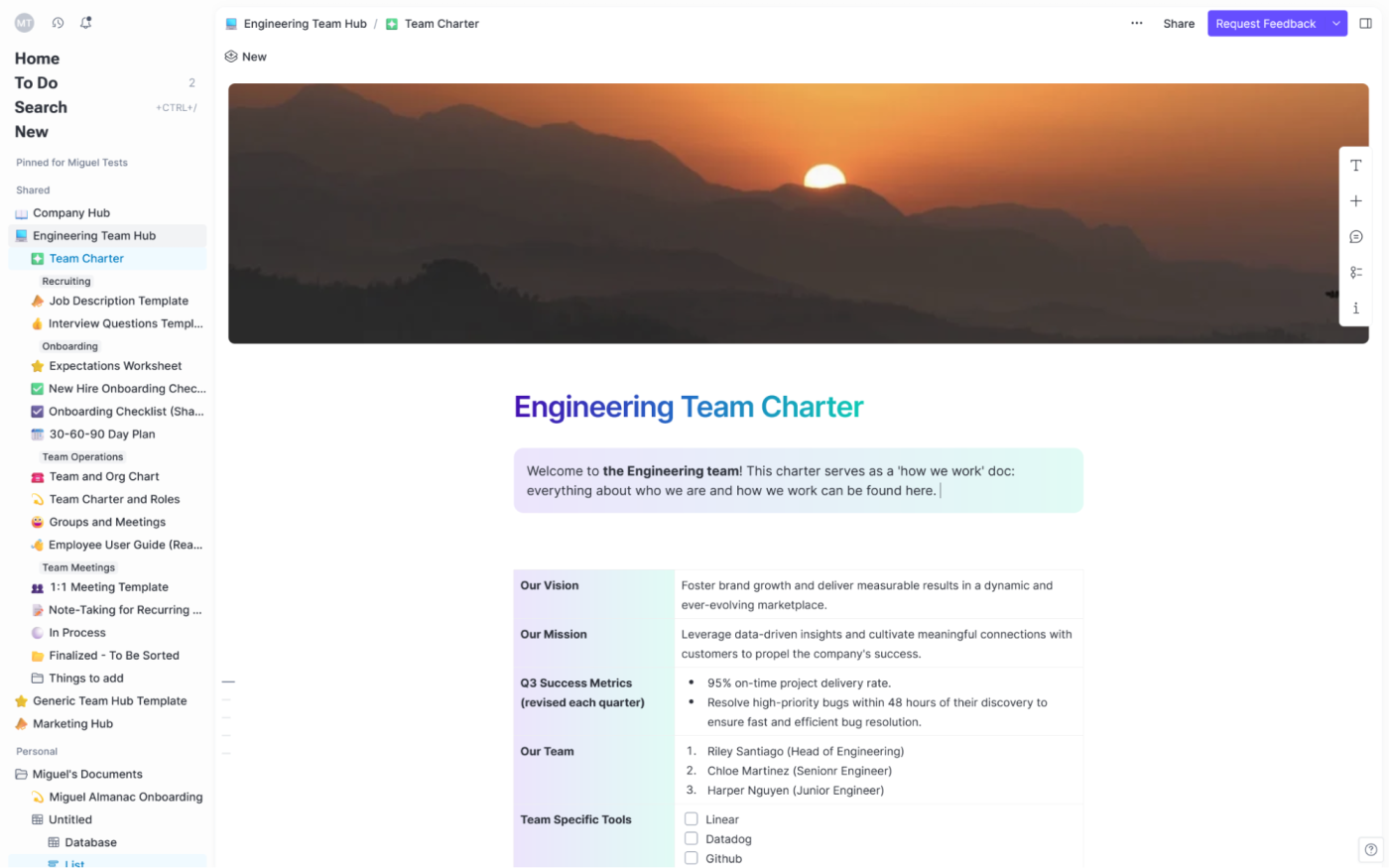
Almanac pros:
Smooth user experience, very similar to Notion
Home screen contains useful entry points into your pages
Almanac cons:
Limited number of integrations
Teams need to move forward together. If it's hard to communicate, share feedback, and collaborate on complex projects, your business will grind to a halt. Almanac has two amazing features that'll prevent this: document versioning and advanced sharing features.
When viewing a document, notice the New Layer button at the top-left of the screen. When you click it, a new copy of the content appears, and you're assigned ownership of that version. Make all the additions and edits you want; they won't affect the main document until you decide to merge it. Before you do merge, there's a really powerful purple button that you need to check out: Request Feedback.
I've used a lot of collaboration tools with my clients and tried many others while testing software, but this is the first time I've seen such a powerful one combining sharing and approval flows. There are two available actions in the Request Feedback button. You can request read receipts with the first one, so if you've made changes to an important internal document and need to get your team's eyes on it, you'll get notified of who has seen what.
The other action lets you request approval from your team. This one is much more powerful and thorough. When you click to start a request, a pop-up will let you add the people who need to approve the document. To keep projects on track, you can add a due date and a message to let them know what you did. If there are reviewers or viewers involved in this document, you can also add them in the respective input fields—be sure to activate these at the top-right of the element. Once the approvers get back to you, you can then merge all the changes you've made into the original document and keep moving forward.
If you're on the opposite end and someone requests your feedback, this will be added to your To Do list, available on the left-side menu. When you open the document and review the changes, you can click the View Summary button to see the analytics of this approval process: the number of comments, suggestions, and tasks, as well as all the team members involved, separated by roles. A timeline shows the main actions taken in the document, and you can add comments here. To finish this process, click the Review or Send Back button: this will let you add a message and then approve, send back, or skip the request.
Almanac makes it really easy to streamline approval processes. If your work is very detail-oriented, requires plenty of iterations, and you need the buy-in or awareness of key people in your team, the toolkit here will make you wonder why you used the Google Docs/Slack combo for so long.
Almanac price: Teams plan goes for $59/month for up to 10 users.
Best Notion alternative for privacy, security, and data relationships
Anytype (Windows, Mac, Linux, iOS, Android)
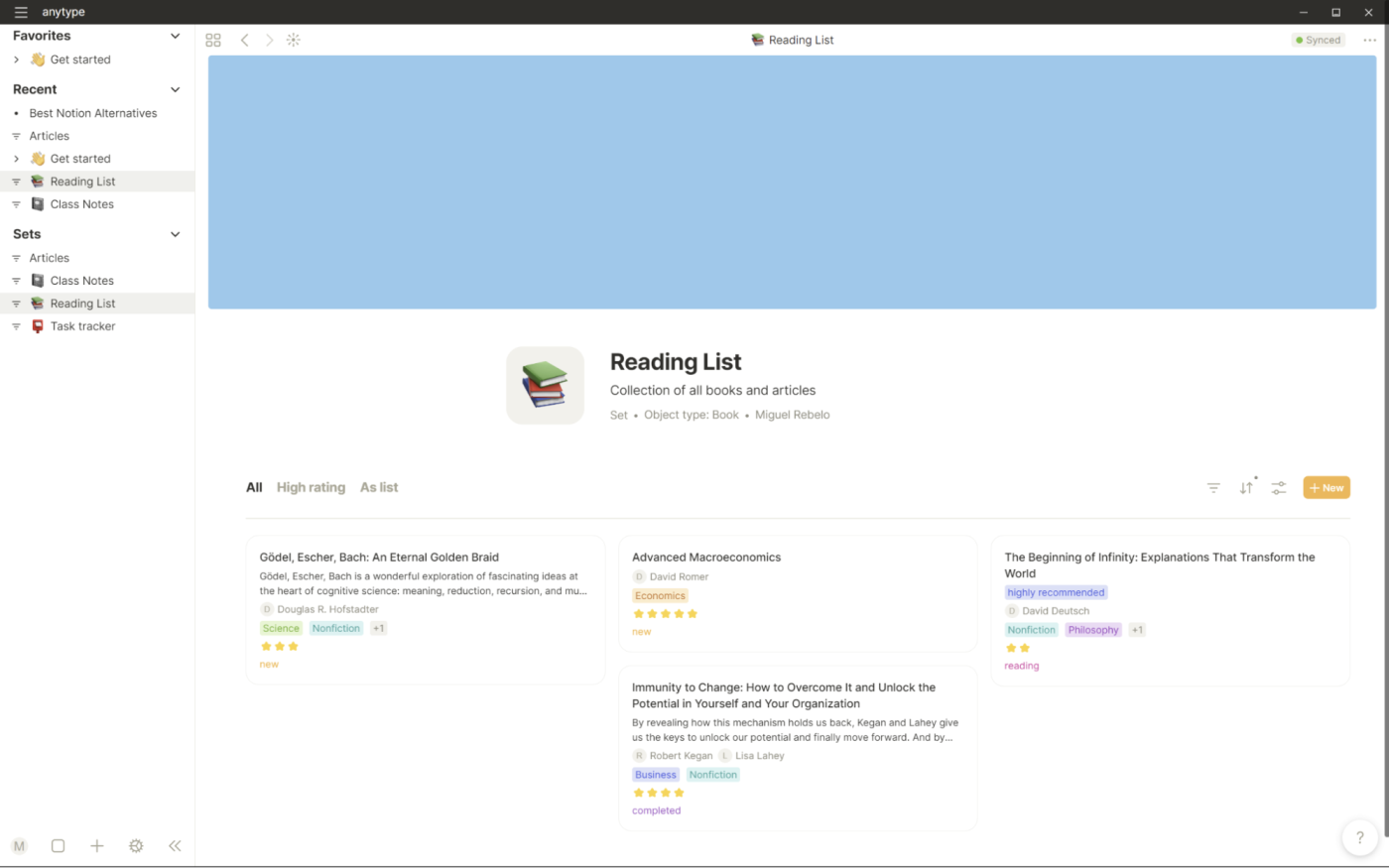
Anytype pros:
Full offline mode available
Fast
Anytype cons:
Limited cloud storage
Anytype is still in development—currently in beta—but already shows great promise as a Notion alternative. It brings its own organization philosophy to the table, so let me quickly break it down for you.
Everything within Anytype is an object. I'm an object with the "human" property. I set relationships with the objects I create, be it documents, notes, or invoices, to name a few. An author of a book I read is an object, the books they wrote (also objects) appear in relation to the author, and the notes I've made about each book (yup, objects) are related to each book in the same way.
This kind of linking through relationships doesn't happen in just one way. Anytype has something called bidirectional linking: linking one object to another enables you to move from A to B, and also from B to A, a bit like backlinks with more features built upon it. This allows you to see information in a visual constellation chart and as a sequence of relationships, where you can navigate upstream or downstream to see how information is connected.
All data lives inside your device, encrypted by a unique passphrase assigned to you when you log in for the first time. Lost the passphrase? Goodbye, data. No one, not even the Anytype team, can recover data without the passphrase. Once you get it, keep it safe in a password manager.
Anytype offers cloud servers to save your data in the cloud and to collaborate with others—enabling the "multiplayer" experience. But if you ever turn off the Wi-Fi, you'll still be able to work. To sync the changes with your other devices, just get in range of the internet again and wait for it to update. This is also the app's monetization model, so if you want more cloud storage and better collaboration, you'll have to hop into one of the paid plans.
Can Anytype work as an all-in-one at the moment? My final verdict is mixed. The document features and the way databases work have a lot of depth, and the app is fast and stable. The fact that there's a cap for cloud storage could be a problem. Is being in development stage a problem? If you need a proven, stable tool, yes; if you want to hop on the forums, engage with other users and the dev team, and suggest your own feature wishlist as you follow the growth, then you'll be delighted by the experience.
Anytype pricing: Free to use locally. Includes 1GB of cloud storage for free, for 3 shared spaces with 3 editors per space. Builder plan goes for $99/year, increasing storage to 128GB, adding unlimited viewers per space, and bumping up editors to 10 per space.
Best Notion alternative for mind mapping
Scrintal (Web, Desktop)
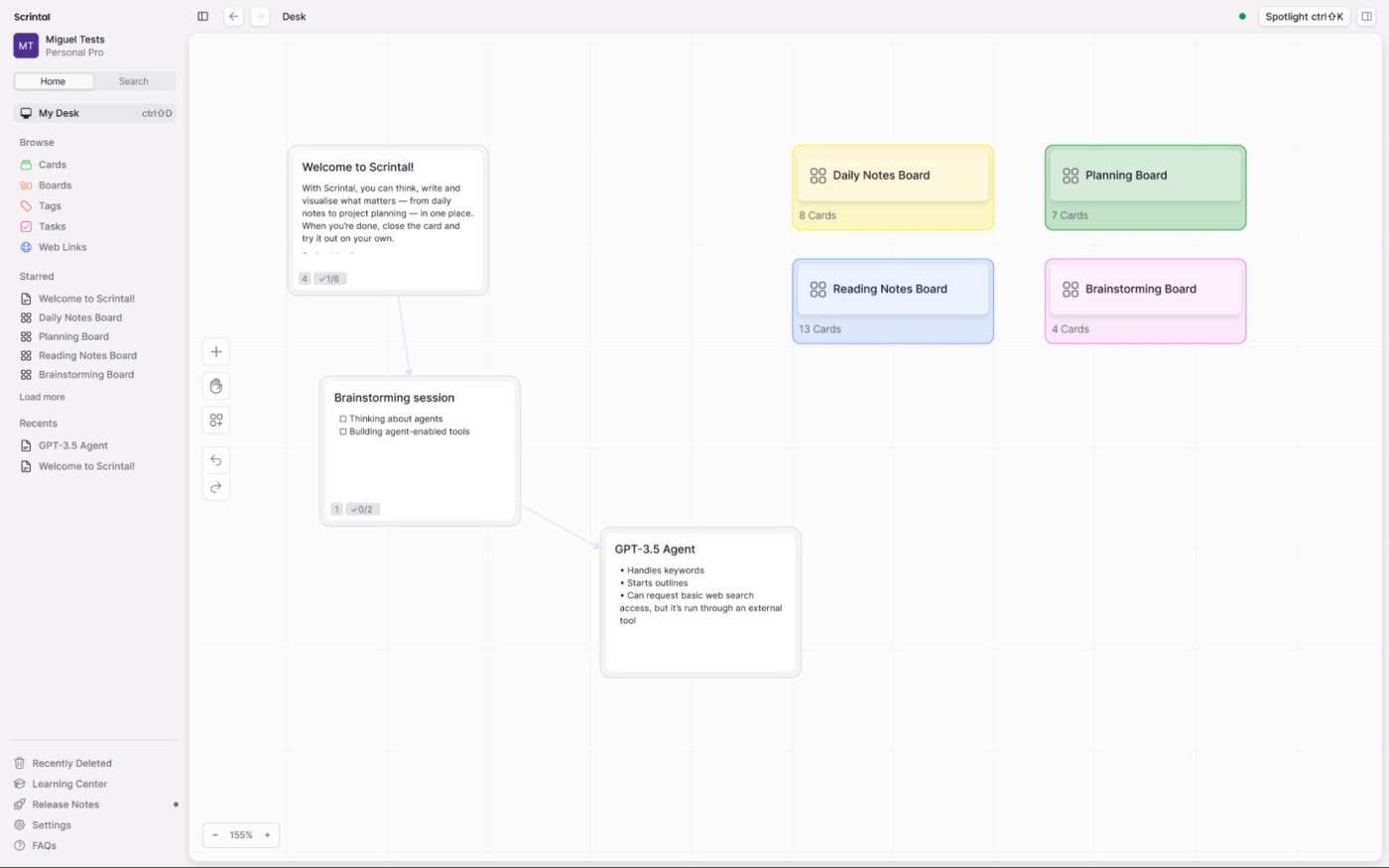
Scrintal pros:
Smooth and easy to use
Good card organization and hierarchy features
Scrintal cons:
Not much power beyond mind mapping
Notion and Miro crashed into one another: the result is a powerful app called Scrintal. If you think in images and diagrams and want a more interesting user experience, you have to check this one out.
The user interface is very similar to Notion: the left-side menu contains links to pages separated by content type, starred, and recently accessed. You can also search from here. Once you're browsing the My Desk section or a board you created, I recommend you collapse the menu: having the canvas fill out your entire screen is much more comfortable.
This is the end of the similarities with Notion. Now, for the Miro part of the deal. With the canvas open in its full glory, click the plus button on the left side to add a new card. Give it a title and some content. You'll notice there are four circles around the card: you can use these to click and drag to connect it to other cards. If there are none, clicking and dragging will create a new card for you, so it's faster to connect ideas without hitting the add button every time.
There are more kinds of elements that you can add to a board. You can add daily cards for journaling or tracking your progress in a project. You can add new boards as well, opening up an entirely new canvas. In addition to these, you can add text, columns (a kind of Kanban view), and web links.
There are formatting controls for the cards, so you can leverage colors and font weights to differentiate knowledge in a visual way. You can drag and rearrange everything to make the information clearer and easier to navigate. There are three card layouts—small, only title, or title and content—so you can also create hierarchies among them. When you're happy with your layout, you can invite people to see your board or publish it to the web with a link in read-only mode.
You can use this one either on your browser or in the desktop versions. It's smooth as butter to move cards and elements around, but I haven't tried zooming out with hundreds of cards with multiple content types on the screen. If you don't have a powerful computer, I recommend you separate your cards using more boards instead of keeping everything in one massive canvas.
Scrintal price: Pro plan goes for $6.99/month. Lifetime plan available for $399.
Best Notion alternative for fearless tinkerers
Obsidian (Mac, Windows, Linux, iOS, Android)
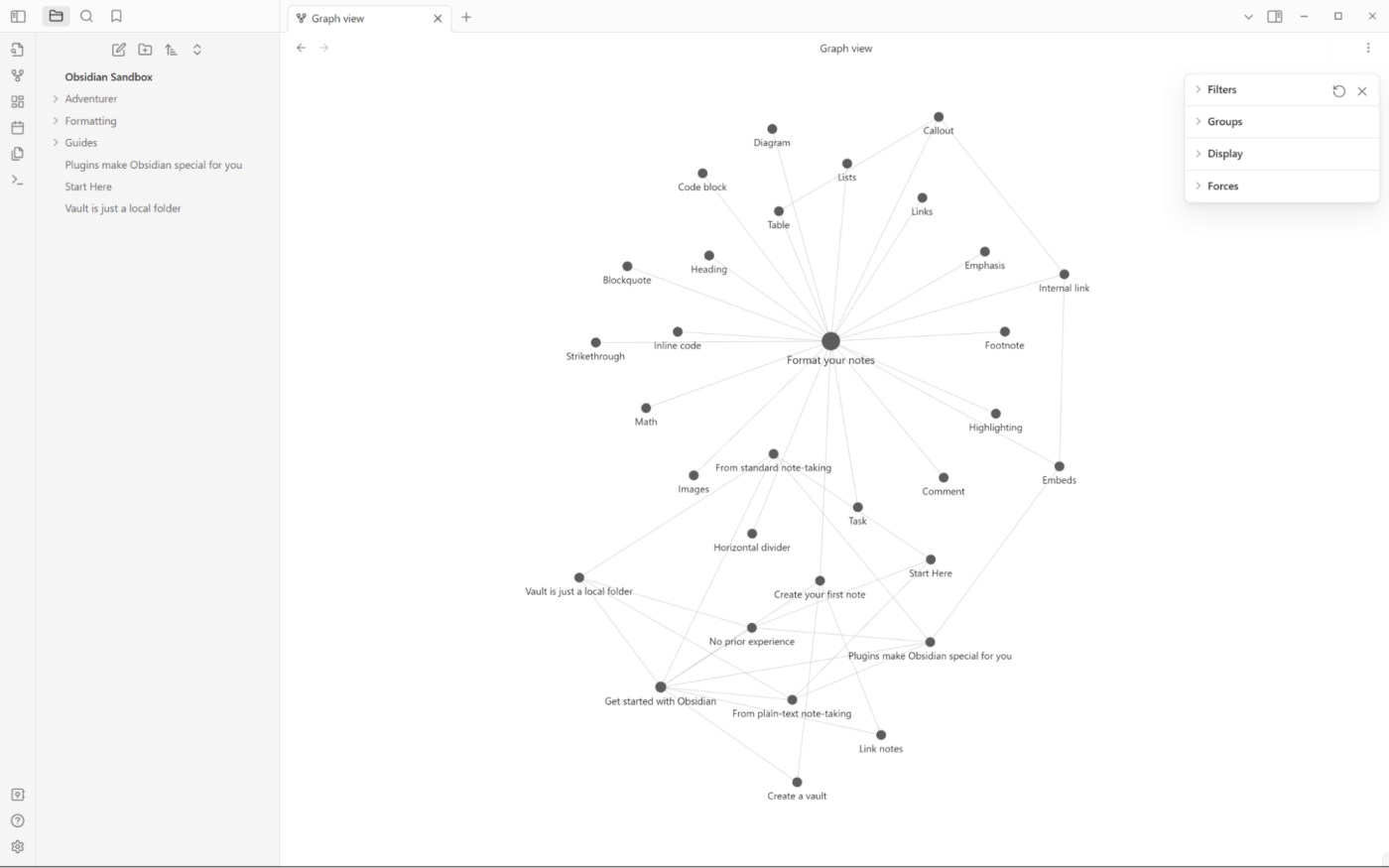
Obsidian pros:
Full offline mode available
Graph view
Obsidian cons:
Can be very complicated to set up extra features
Obsidian brings a unique open-endedness, inviting you to customize it with dozens of plugins. At heart, Obsidian is a note-taking tool with a graph view, allowing you to see your ideas in a constellation. Most of the advanced features and plugins are turned off by default, but going to the settings menu will give you a long list to play around with. And while you can do a lot already with these first-party plugins (such as enabling a slash command menu), the community plugins allow you to add extra functionality to the app itself.
The most exciting part of this app is that you can transform it to suit your needs. Depending on your technical knowledge (or fearlessness), you can set up Kanban boards, calendars, and to-do lists; configure a spaced repetition system; and even add sketches to your notes. This isn't even the full list; there's a lot more to discover.
All your documents live inside a "vault." Since everything is stored locally—in a folder on your computer as Markdown files—your data is always yours. If you want to sync your data to the cloud, you can upload this folder to your file storage app of choice.
Collaborating with others requires some acrobatics, at least while the Obsidian team builds those features into the app. The easiest way is to create a vault, upload it to Google Drive, and share it with your team. Other methods include (brace yourself) setting up a free-tier server on a cloud hosting provider and connecting a live editing plugin.
Adding a database experience also requires tinkering, but some advanced users have successfully created their own database views inside Obsidian, even replicating (and surpassing) Notion's database experience.
Is there all-in-one potential in Obsidian? Absolutely. Will it require you to learn as you go and invest a lot of time and patience? Yes, it will. And the end result might be a tool perfectly tuned to the way you gather, think about, and communicate information. High investment, high reward.
Obsidian pricing: Free for personal use. Sync add-on enables cross-device syncing for $4/month. Publish add-on lets you create a site for your notes for $8/site/month. Commercial licenses available at $50/user/month.
Can Notion be beaten?
This category of Notion alternatives includes all sorts of approaches and features—some solutions start with entirely different mindsets. All the platforms on this list are either free or have a free plan to help you evaluate the features on offer, so take your time to experiment and see which one matches best with what you need. And hey, maybe Notion is the app for you after all.
Related reading:
Notion comparisons: Notion vs. Roam, Notion vs. OneNote, Notion vs. Evernote, Craft vs. Notion
This article was originally published in April 2022. The most recent update was in June 2024.
